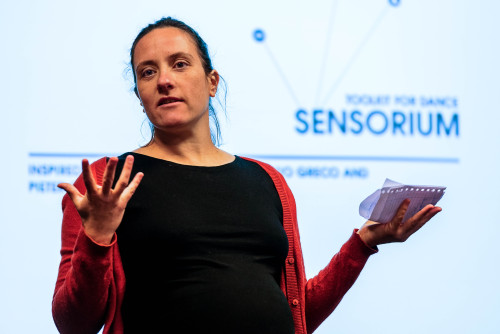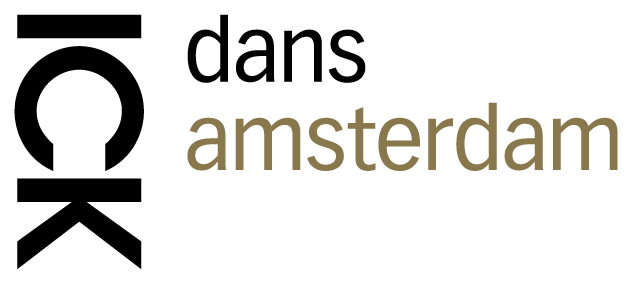Text: Lidwien Berkhout, Barbara Meneses, Jesse Vanhoeck
Dance Connects organizes modern dance classes for seniors (60+). In four weeks, Barbara Meneses gave them an introduction to the Double Skin/ Double mind method. ICK is interested to investigate how the DS/DM method can work or be adapted for aging bodies. After an initial introduction, a series of more in-depth workshops followed where also the Sensorium – Toolkit for dance came into play. ICK wants to think further about how the method can be adapted even better to this target group and what kind of benefits this can bring to them.
Lidwien Berkhout, dance connects member
“When I heard that we were going to attend several Double Skin/ Double Mind workshops at ICK, I had no idea what that meant. In the first lesson Barbara explained how the method was developed and what the basic principles are: breathing, jumping, expanding, reducing. Then we went to work to experience what it’s like to do these exercises one after the other. It took me some time getting used to it. Especially because the exercises are repeated quite a lot and done for a longer period of time.
Ageing means being confronted with constraints that are different for everyone. However, everyone could follow this workshop. In our group we participated as much as possible according to our own abilities. The experience also differs from person to person. I thought the workshop was easy to follow. It also stimulated me to go a step further than I thought would be possible. During the jumping part, I suddenly got in a flow and could go on for a long time.
Breathing is important for your (dance) movements. It facilitates/strengthens your movements. Even though I am aware of its importance, I sometimes forget to use it properly in daily live activities. Doing the exercises draws your attention to the fact that you can use breathing to strengthen your movements.
Jumping was a very nice thing to do. Let your arms hang loose and let them move with you. The gaze is, unlike in yoga, directed outwards and during jumping you meet the other dancers, you share the energy and you see what happens with the movements. It is very playful.
Expanding and reducing is about moving bigger and smaller. I found the barely perceptible movements in reducing very special. Making movements larger, I think, is more in my nature while making them smaller requires more awareness of yourself. It stimulates you to subtly show the power of your movements. The reducing evoked the image of a tamed force or energy.
I really enjoyed doing it. The workshops were both strenuous and relaxing at the same time. After the workshop I always felt supple, loose, clear, relaxed. “
Barbara Meneses, teacher

Also for teacher Barbara Meneses it was a whole new experience to work with this target group. She was pleasantly surprised by the openness of the group, their enthusiasm: ‘I thought they were very fit and they had no trouble at all to improvise’.
“Ageing comes with all kinds of consequences. For some, their bodies and minds start to encounter bigger and new limitations, others are not yet there, they are even more fit than most of younger amateurs. The process of ageing and, more importantly, the way their bodies and minds are accepting it and adapting to it, is different for everyone and therefore there are big differences in the group.
But all of them have, obviously, a larger life experience. And that is so rich. More memories, more references, more knowledge. This is mainly visible when it comes to improvisation or to more creative exercises. Give them elements from the Sensorium toolkit like the smells, which make a direct link in your brain with memories, and they will come up with a richer pallet of possibilities than any other age group.
From the experience of working with this group I have grown a lot of respect for them.Dancing, moving, being social and staying creative is surely very beneficial and positive for them but it is also a sign of vitality and inner strength. Dance is a very confronting art form, for anyone. You encounter your limits over and over again, it is the only way to grow. In the case of elderly dancers, the limits and borders of what they can do, physically and mentally, can have another layer of meaning. Sometimes they experience limits and through working on them, they are able to move them a bit further away and create more room for themselves. But sometimes new limits appear, they are unmovable and have come to stay. The challenge is to learn how to deal with them, accepting the new situation and adapting to it. I think to put yourself in that position requires a lot of inner strength. It’s admirable.
The idea to collaborate with Dance Connects Company came from their director Floortje Rous and it was immediately very attractive to me. The soul of the ICK Academy projects is directly linked with the DS/DM workshop and we continue to investigate how the method can be widely used and maintains its relevance in different contexts. The purpose of the collaboration with Floortje and the Dance Connects Company was to see if the DS/DM method and the Sensorium Toolkit could be used as tools to help Floortje (re)discover her dancers and their individual and unique qualities, to get more out of each of them. Given the heterogeneity of the group our goal was simple: the workshop had to be inclusive, it was a must to provide a DS/DM which was accessible for everyone in the room, no one could feel excluded. I tried to create a DSDM which could be done entirely while walking or constantly shifting weight, chairs were always in the room to be used as support whenever they wanted to.
The Jumping part of the DS/DM is one of the toughest physically so we tried to recreate the essence of the jumping (rebound, rhythm, shapeless body, awareness of your skin) with a much gentler form, and I think it worked. And I didn’t do this just by myself, the collaboration with Floortje, her knowledge about her dancers and her input and ideas were very important.

We learn about the method by confronting it with different target groups, because for each specific target group the DS/DM needs to be adapted in order to be, first, welcomed by the participants and then, have a significant impact on them. In order to adapt the method, we need to question it over and over again. What are the essential elements of the DS/DM, which of those elements are of value for the target group, what are the elements that on the contrary might produce a resistance in the participants and what happens if we remove/transform those? How far can we go from the original and still call it DS/DM?
It was a very inspiring process for everyone and as a conclusion we have decided to continue the collaboration further. After the summer we will continue working with the group of dancers using the Sensorium Toolkit, this time to create a 20 minute piece based on their improvisations, the result will be presented in the coming ICKfest in October 2019.
Photos: Alwin Poiana, Bas de Brouwer, Floortje Rous


0 Comments